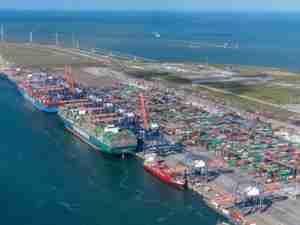With the including an 85% reduction in cancer risk from port-related diesel pollution by 2020. In the works for two years, the CAAP Update is consistent with the ports’ pledge in the original CAAP that the plan would be a living document, updated periodically to ensure it remains current and forward-looking. The original CAAP established the most comprehensive strategy for reducing port-related air pollution and associated health risks. The plan ushered in an array of air pollution control initiatives. Among them: the ports’ award-winning clean truck programs, vessel pollution reduction programs, and a Technology Advancement Program (TAP) that fosters the development of “clean technology” applications, like the world’s first hybrid-electric tugboat, all-electric Class 8 port trucks, and the nation’s greenest short-line railroad.
“This updated Clean Air Action Plan underscores the ongoing commitment our ports have made toward reducing our impact on surrounding communities and the region,” said Port of Los Angeles Executive Director Geraldine Knatz, Ph.D. “By lowering emissions we can continue to develop the best port facilities, serve our customers’ needs and create thousands of good-paying jobs.”
“The Clean Air Action Plan, forged in cooperation between the ports and the regulatory agencies, has been extremely successful. Much of this success is due to our industry partners, who have accepted the challenge and responded with diligent efforts to clean the air,” said Richard D. Steinke, Executive Director of the Port of Long Beach. “Now it is time to revisit, strengthen and update our programs and long-range goals with this revision to the CAAP.”
Over the three and a half years since the original CAAP was adopted, the ports of Long Beach and Los Angeles have demonstrated their ability to work with industry and implement initiatives that achieve emissions and health-risk reductions. In addition, significant regulatory changes have reduced emissions from all port sources: ships, locomotives, terminal equipment, trucks and harbor craft. The proposed CAAP Update builds on these successes, outlining strategies for the next five years, and identifying longer-term goals that will help the ports, regulators and the industry to achieve further air quality and public health improvements. These strategies will also allow port development and support the flow of goods so vital to the region’s economy.
The ports expect to exceed the estimates for reducing air pollution within the original CAAP’s five-year timeline. And going forward, the ports propose, as part of the CAAP Update, to adopt new “San Pedro Bay Standards” that will set ambitious and comprehensive air quality and health risk goals. Based upon a framework of state and federal air quality regulations and corresponding target dates, the Standards set goals for cancer risk reductions by 2020, as well as a series of emissions reductions by 2014 and 2023. To achieve all this, the CAAP will rely on a mix of existing technologies and strategies for the near term, technological advances that have yet to be identified to meet the long-term goals, and ongoing regulatory initiatives at the state, federal and international levels. Given the long-term trend for innovation in clean-air technology and the ports’ multimillion-dollar investments in a Technology Advancement Program, port officials are confident that new solutions will be created to help meet the ambitious new goals.
With the public release of the proposed CAAP Update, the ports have set a 30-day comment period to end May 7, 2010. Two public meetings have been scheduled










